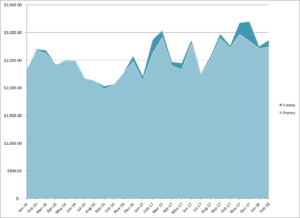Stock Video Part 2 – What I take
Earlier in the week I wrote the first of several posts on stock video. Today I’ll move forward to look at the sort of stock videos I’ve been taking and how successful they have been. By the way, if you haven’t read it yet, it is worth looking at the comment added by Vlad Savin to that first post. He provides a very good background to the video industry use of B-Roll to fill in gaps in their productions. It really helps to explain what we are producing this stuff for!
As I mentioned before, I’m relatively new to stock video, but the videos are starting to make a difference to my earnings:
Of course in comparison to the still image or photo earnings they are still pretty small:
So what sells for me and what do I try to produce. In 2016, the fireworks video I mentioned last time was still my best earner with $259 that year. The other ones we mainly still images that I created movement on in Photoshop – either panning or zooming into an area of the image. With distant landscapes and cityscapes, it is quite difficult to tell the difference between this and a zoomed video, although I did read that they were sometimes rejected as just a manipulated still image (which they are!). I often see this sort of shot in the B-roll video, and I would have thought some customers would prefer to buy it rather than create it themselves, but I’ve given up creating this sort of thing. An example of what has sold well in the past (during the financial crisis) is this one:
When I restarted my video adventures in 2017, I started with what I found worked well in stock photos – bitcoins and the opioid epidemic in the USA! I quickly found that macro imagery with movement is quite tricky to do! With zooming, you have the issue of smoothness and also the narrow depth of field with macro shots. Panning shots are equally difficult to do smoothly – even with a fluid head on a video tripod. I wanted to do 4K video because although there are many clips online of many subjects, there are fewer 4K shots and I thought that would give me an edge. With a 4K video, the user can crop into the video if they want to use it in a normal HD production, which gives it more flexibility. I bought myself a video slider to help with smooth panning movements, but even that was pretty tricky. I think that your use of a video slider really requires a lot of practice to get smooth continuous movement and perhaps I didn’t have the patience for it. I tried various ways to try to mechanize the movement, but nothing was that good! I sold the video slider this past week after only a few uses – write it off as a tax loss I guess!
So what made the difference in my macro work was another investment – the Edelkrone Surface One. This is not cheap by any measure (although it is 10% off today!) and the package cost me $840 in total. However, it has definitely earned its keep for me. Basically the device holds a normal digital camera and can pan sideways, move forwards, rotate around a fixed point with the camera focused on that point at various speeds and angles:
I use mine on the dining room table which provides the smooth surface for the device to run on.
I received it in October 2017, and probably $800 of my $1500 video sales in 2017 came from clips that used this device. My best seller in 2017 was this one:
As you can imagine, a shot this close would be very difficult (at least for me) to do manually, but the Edelkrone produced it with no issues. I should mention how I process videos (I’ll come back to this in the next post). For a long time I used Photoshop, which has some pretty good tools for handling video as well as being able to use all the normal color correction and improvement filters. But I decided to switch to Premiere because it has a really good “shake removal” process that removes the small wobbles that I get even with the Edelkrone. It is called the Warp stabilization effect and it does a great job on all sorts of clips – smoothing out hand held shots as well as some of these very close macro clips. Here is an example of how it handles rotation:
So macro shots of my favorite subjects really helped me get moving with video, but I didn’t want to rely just on those being in the news. I bought a GoPro Hero 4 and a suction mount early in 2017 and took that on vacation to Hawaii. I wanted to drive the cliff edge road down to Hana, and then carry on around the south of the island on the road that tourists are usually warned to avoid! Some of the other cars round there were amused to see my rental car with video camera on the hood, but the shots I took (mainly HD to use the in-camera stabilization on the GoPro) have sold well and continue to sell:
I’m told that these Point of View (POV) driving shots do seem to sell – not just of vacation shots but on the typical roads into many cities – again I can see their use behind a new reader when some news event has happened in a particular city and they want some video to add color.
This year I have done some tax clips that have sold:
And I have just uploaded some real life people shots (of course using myself as the model) from a cruise we took earlier in March. These are just newly online and so have no sales so far:
I hope these will have given you some background about how I approach stock video. If you want inspiration from a master, you can do no better than check out this site from a friend of mine. I wish I could create beautiful shots like the ones in the demo reel with the model under the tree!
My next post will be on the more technical aspects of producing video.









Once again, Steve has proved he is a stock photo worthy of following. His creativity is just awesome. Now that he is moving into video, anyone interested in producing stock video should be subscribing to learn more from Steve.
Thanks George! I’m not a natural yet at this new skill, but I’m working on it!
Hi Steve, thanks for the post. Just curious, have you tried selling timelapse videos, and do you think there is a large demand on them? How about 4K videos? Is there demand on them? I have made a few 4K videos, but nothing was sold so far. The demand is still on HD, at least for me. What do you think?
Hi Mohammed
I’ve done a couple of timelapses but I don’t recall a sale of them, but my sample size is too small to really tell you much. I think those busy cross road type shots might sell well, but I’m not sure about the use case for a sunrise or sunset landscape video for instance. I always do 4K video now and have had occasional sales at the 4K size. Most of the time the buyer opts for the HD version, but over time that might change. It is better to have the 4K file size online for when they do decide they need something more detailed or they want to crop into it.
Steve
Ok, now video ideas are sprouting in my mind…
Great post again 😉
Thanks, very helpful… i just bought a motorized slider + a pan / tilt motorized head. I can not wait to go out and play when the good weather arrives in my part of the country!
Good luck!